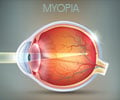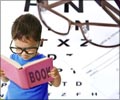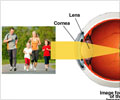Do you have a blurry vision? Do you have difficulty in reading or experiencing any other vision problems? If your answer is yes, please check our calculator to test your eyes for myopia or near-sightedness.
Near sightedness is a visual impairment that blocks a healthy vision. Near-sighted people can see the closer objects clearly but objects at the distance would appear blurred. Hence, early detection and treatment are important to restore your eye health. This test is carried out using Snellen or Tumbling E chart. These online charts have been modified to make them convenient for you to use and is not a replacement for the standard test that you take in the hospital environment under the guidance of an eye doctor.
If your child's vision test indicates that the distance visual acuity is less than 20/20, myopia (Near-sightedness) could be developing. Almost one-third of the school children develop myopia where they find it difficult to read the blackboard in their classrooms.
| Age Group | Recommended Visits for eye check-up |
| Birth to 24 months | Between the ages of 6 and 9 months |
| 2 to 5 years | At least one eye examination between the ages of 2 and 5 years |
| 6 to 19 years | Once in a year |
| 20 to 39 years | Once in every 2 to 3 years |
| 40 to 64 years | Once in every 2 years |
| 65 years or older | Once in a year |
| ❖ | According to World Health Organization, globally, 285 million people are visually impaired of which 39 million are blind. |
| ❖ | It is estimated that more than 82% of all blind people are 50 years of age or older. |
| ❖ | Recent statistics conducted by WHO reveals that around 90% of the people with visual impairments live in the developing countries. |
| ❖ | In low-income and middle-income countries, cataract is one of the major causes of blindness. |
| ❖ | Around 80% of the vision problems are treatable. |
| ❖ | The major causes of visual impairment include:
|
| v | About 19 million children below 15 years of age are visually impaired and 1.4 million are completely blind. |










